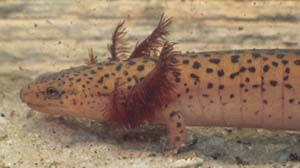Education:
- Ph.D., University of Michigan
Since coming to Appalachian I have taught several different courses, however herpetology, mammalogy, and evolution have been standards throughout the ages. In all these classes, I strive to present the students with relevant information and challenge them to come up with solutions to various problems and challenges. Most cut-and-dried issues bore me, so all my classes get to see where people are working now and learn about the hottest new techniques. I try to show students a broad cross-section of the diversity of the focal groups although I probably spend too much time dealing with taxonomy and systematics. I expect students to do a lot of work on their own and to spend a lot of time working with animals.
I have had graduate students since I first came to Appalachian and hope to continue working with them as long as I stay here. Most of my students work fairly independently on problems related to their own interests. Over the years they have worked on mammal community structure, predator-prey interactions, basic life histories of various salamanders, faunal surveys, feeding behavior, radiotelemetry, and GIS mapping problems.
My own research over the past few years has focused on the life history of local salamanders. I have followed the growth of red salamander larvae in several local sites for the last 20+ years and hope to actually learn something about how they respond to annual variations in rainfall or temperature. Several students have looked into population issues with salamanders, including population and biomass estimations, electrophoretic surveys, and biogeographic studies. I have also maintained a real interest in amphibians and reptile systematics and provide materials to many workers in that field. I have been photographing amphibians and reptiles for the last thirty years and use this tool to focus my attention on "key" characteristics of a wide range of creatures. I am now working on a couple of CD's with photographic illustrations from my various classes. I also maintain an active interest in the various theoretical ramifications of mimicry. Who says we have to become narrower as we get older?

Photo of a southern Appalachian red salamandar, Pseudotriton ruber
Selected Publications:
- Van Devender, R. W. (1998) A new look at the Batesian-Mullerian Mimicry spectrum._ Invited paper presented at joint meetings of SSAR, ASIH, HL at University of Guelph, Ontario, Canada._ June.
- Van Devender, R. W. (2000) Herp escape to Brazil._ Paper presented at spring meeting of North Carolina Herpetological Society. Boone, NC. April.
- Van Devender, R. W., and Lapp, K. (2000) Estimates of terrestrial salamander biomass at Saddle Mountain, Surry County, NC, USA. Paper presented at joint SSAR, HL, ASIH meetings in La Paz, Baja California, Mexico. June.
- Ball, B., and Van Devender, R. W. (2000) Home range of eastern hellbenders, Cryptobranchus alleganiensis alleganiensis: A radiotelemetric study. Paper presented at joint SSAR, HL, ASIH meetings in La Paz, Baja California, Mexico. June.
Scientific Photography:
Van Devender, R. W. (1998) 98 color and 96 black & white photographs. In: James Petranka. Salamanders of the United States and Canada. Smithsonian Institution Press. Washington, D.C.
Van Devender, R. W. (1999) Cover photograph of alligator snapping turtles for Science 283(5404), 12 February.

Title: Professor Emeritus, Evolutionary Biology, Population Dynamics, Herpetology and Vertebrate Biology
Department: Department of Biology
Email address: Email me